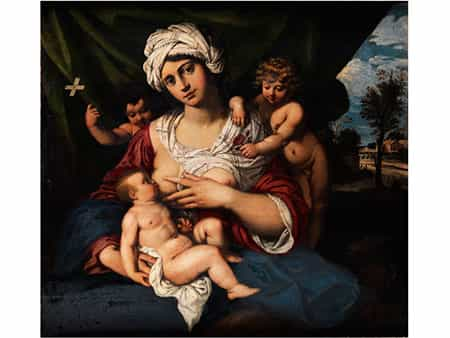Aste Dipinti XVI - XVIII secolo
» rimettere
Il Vostro Art Agent personale

Siete interessati alle opere di Francesco Cozza?
Volentieri Vi teniamo aggiornati, quando le opere di Francesco Cozza verranno offerte in una delle nostre prossime aste.
Vi preghiamo di accettare la nostra politica sulla privacy
385
Francesco Cozza,
1605 Stignano - 1682 Rom
ALLEGORIE DER BARMHERZIGKEIT Öl auf Leinwand.
114 x 124 cm.
Prezzo del catalogo € 30.000 - 60.000
Prezzo del catalogo€ 30.000 - 60.000
$ 32,400 - 64,800
£ 27,000 - 54,000
元 234,600 - 469,200
₽ 2,984,700 - 5,969,400
Beigegeben eine Expertise von Luigi Salerno.
Francesco Cozza wurde in Kalabrien geboren, ging jedoch schon bald nach Rom, wo er um 1645 bei Domenichino lernte. Er war ein vielschichtiger Künstler, der die Einsamkeit liebte, aber sehr aufnahmefähig war. Anfangs orientierte er sich am Bologneser Klassizismus und somit natürlich an seinem Lehrer. Er besaß jedoch mehr Gespür für den Naturalismus, dennoch bewegte er sich weit ab von Caravaggio. Man bemerkt in seinen Werken manchmal Anklänge an Giovanni Lanfranco, Gian Domenico Cerrini, Francesco Romanelli und Mattia Preti, der ebenfalls aus Kalabrien stammte. Seine Landschaften waren ihm immer sehr wichtig - wie man auch auf dem vorliegenden Werk sehen kann - und lassen den Einfluss von Gaspard Dughet und Pier Francesco Mola erkennen.
Unser Gemälde zeigt eine Allegorie der theologischen Tugend der „Caritas“ und folgt den ikonografisch typischen Modellen des 17. Jahrhunderts, wo es vor allem um die Darstellung der Nächstenliebe geht.
So sehen wir hier eine üppige Frauengestalt mit nackten Brüsten, die ein Kind stillt, während zwei weitere Kinder sie umringen, von denen eines ein rudimentäres Holzkreuz in den Händen hält. Dieses Modell entsteht sicherlich aus der Darstellung der „Mater lactans“ (auch genannt „Madonna del latte“), wie sie Francesco Cozza bereits für den Altar der Kirche San Secondo in Gubbio malte (datiert 1637). Das vorliegende Gemälde besitzt eine einfache Aufteilung, die jedoch sehr direkt und ansprechend ist; die Formen sind sehr klar und von hoher Plastizität. Stilistisch, aber auch vom Charakter und der Physiognomie der Figuren her erinnert das Gemälde an Werke Cozzas um 1650, wie zum Beispiel die „Madonna del Cucito“ der beiden Versionen in der Kirche San Secondo in Molfetta und der Quadreiria dell’Ospedale di Santo Spirito in Sassia in Rom, die „Natività della Vergine“ in der Galleria Colonna in Rom, die „Madonna che adora il Bambino e quattro angeli“ in der Pinacoteca Provinciale in Bari und schließlich die „Madonna del Riscatto“ im Pontificio Collegio Nepomuceno in Rom (signiert und datiert 1650). (1021648) (21)
Francesco Cozza,
1605 Stignano – 1682 Rome
ALLEGORY OF MERCY
Oil on canvas.
114 x 124 cm.
Accompanied by an expert’s report by Luigi Salerno.
Francesco Cozza was born in Calabria, but soon left for Rome, where he became a student of Domenichino in ca. 1645. At first he orientated himself towards Bolognese Classicism and naturally, his teacher. His works at times show affinities with Giovanni Lanfranco, Gian Domenico Cerrini, Francesco Romanelli and Mattia Preti, who also came from Calabria. Landscapes were always an important subject for him and they reveal influences by Gaspard Dughet and Pier Francesco Mola.
The present painting shows an Allegory of the theological virtue “Caritas” and follows the typical 17th century iconography, where the depiction of Charity is paramount. This model was surely derived from the depiction of the “Mater Lactans” as painted by Francesco Cozza for the altar of the San Secondo Church in Gubbio in 1637. The present painting shows a simple, straightforward and appealing composition; the forms are very plain and sculpturally modelled. The painting’s style, character and the figures’ physiognomies are reminiscent of works by Cozza ca. 1650, such as both versions of the “Madonna del Cucito” in the San Secondo Church in Molfetta and the Quadreiria dell’Ospedale di Santo Spirito in Sassia in Rome, and the “Natività della Vergine” in der Galleria Colonna in Rome.
This object has been individually compared to the information in the Art Loss Register data bank and is not registered there as stolen or missing.
Il Vostro Art Agent personale
Volete essere informati quando nelle nostre prossime aste un’opera di Francesco Cozza viene offerta? Attivate qui il Vostro Art Agent personale.
Vi preghiamo di accettare la nostra politica sulla privacy
Volete comprare un′opera di Francesco Cozza?
Il Vostro Art Agent Comprare in Private Sale Date delle aste
I nostri esperti sono felici di assistervi personalmente nella Vostra ricerca di opere d′arte
Volete vendere un′opera di Francesco Cozza?
Consegnate ora Vendita privata FAQ
Le vostre consegne sono sempre benvenute. Il nostro team sarà felice di assistervi personalmente in ogni fase trattative. Aspettiamo le vostre chiamate.
Contattate i nostri esperti
further catalogues Mobili & Arredamento | Arti Applicate, mobili in miniatura, argenti, maioliche, Arte Russa | Arte asiatica | Dipinti XIX - XX secolo | Dipinti XVI - XVIII secolo | Asta di beni di lusso: Hermès, Louis Vuitton | Asta di beni di lusso: Gioielli | Asta di beni di lusso: Orologi da polso | Arte moderna | Prima parte della Collezione Napoleonica di Jurgen Kattwinkel | Hampel Living
















